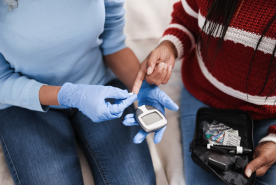What is minimal change disease?
Many diseases can affect your kidney function by attacking and damaging the glomeruli, the tiny filtering units inside your kidney where blood is cleaned. The conditions that affect your glomeruli are called glomerular diseases. One of these conditions is minimal change disease (MCD). Minimal change disease is a disorder where there is damage to your glomeruli. The disease gets its name because the damage cannot be seen under a regular microscope. It can only be seen under a very powerful microscope called an electron microscope. Minimal change disease is the most common cause of nephrotic syndrome in children. It is also seen in adults with nephrotic syndrome, but is less common. Those with MCD experience the signs and symptoms of nephrotic syndrome much quicker than they would with other glomerular diseases.
What causes minimal change disease?
In adults, the disease is usually secondary (it is caused by another disease or drug). In children, MCD is usually primary (or idiopathic, which means the exact cause is not known). If you have secondary causes for MCD, the disease may occur or be related to:
- Allergic reactions
- Use of certain painkillers called non-steroidal anti-inflammatory drugs (NSAIDs)
- Tumors
- Infections caused by a virus
What are the signs and symptoms of minimal change disease?
You may notice the following signs and symptoms of MCD:
- Foamy urine due to large amounts of protein leaking into your urine, called proteinuria
- Swelling in body parts, like your ankles and around your eyes, due to fluid building up in your body, called edema
- Weight gain due to the fluid your body is not able to get rid of
- Nephrotic Syndrome: A set of symptoms that happen together and affect your kidneys. These include:
- Swelling in body parts like your legs, ankles, or around your eyes (edema)
- Large amounts of protein in your urine (proteinuria)
- Loss of protein in your blood
- High levels of fat or lipids in your blood (high cholesterol)
Always speak with your doctor if you experience any of these signs and symptoms.
Minimal Change Disease
Sign up for a deep dive into Minimal Change Disease
Learn about Minimal Change Disease, receive additional resources, and learn so much more.
How is Minimal Change Disease Diagnosed?
The first clues are the signs and symptoms. Your healthcare provider may run tests to help understand the cause of your symptoms and find the proper treatment for you.
These tests are:
- Urine test: A urine test will help find protein and blood in your urine.
- Blood test: A blood test will help find levels of protein, cholesterol, and wastes in your blood.
- Glomerular filtration rate (GFR): A blood test will be done to know how well your kidneys are filtering the wastes from your body.
- Kidney biopsy: In this test, a tiny piece of your kidney is removed with a special needle, and looked at under a microscope.
If a kidney biopsy shows little or no damage under a regular microscope, then a diagnosis of MCD may be made if other symptoms, such as protein in the urine and swelling, are noticed. Because MCD is the most common cause of nephrotic syndrome in children, they first get treated for MCD before getting a biopsy. Most people will have a response in fewer than 8 weeks. If the protein in the urine disappears, the doctors may call the disease steroid-sensitive nephrotic syndrome instead of MCD. If treatment does not improve their symptoms over the course of several months a biopsy is done to see if there is another cause for their symptoms.
How is minimal change disease treated in children?
MCD is usually easier to treat than other glomerular diseases. The treatment plan for nephrotic syndrome in children with MCD is usually with a type of drug called a corticosteroid, often called steroids. It is very important to not stop treatment suddenly. By sticking to the full treatment plan, your child will be less likely to relapse (experience the signs and symptoms again).
For children who do not respond to traditional treatment they have what is called steroid-resistant nephrotic syndrome or SRNS. Treatment for SRNS includes other combinations of drugs. It is recommended that children with SRNS take a blood pressure medication (ACE inhibitor or ARB). These two drugs control high blood pressure and reduce the amount of protein in the urine.
How is minimal change disease treated in adults?
The treatment for nephrotic syndrome in adults with MCD is usually with a type of drug called a corticosteroid, often called steroids. You may notice that you start getting better within weeks, or less, although it may take an adult longer to respond than a child. It is important to stick with your treatment plan until all medications are finished; even if your symptoms go away sooner
If you are a woman and want to have children, you should speak with your healthcare provider to see how the medicines you are given affect this process.
For symptoms of swelling (edema), your healthcare provider may give you:
- ACE inhibitor or ARB medicines
- Diuretics (water pills)
- Limit sodium (salt) in your diet
Will minimal change disease cause kidney failure?
Kidney failure is rare if you have minimal change disease. Almost all children and adults recover from MCD and avoid relapses over the long term. However, some may experience relapses of the protein in the urine, which can often be treated in the same way as the first episode.

















